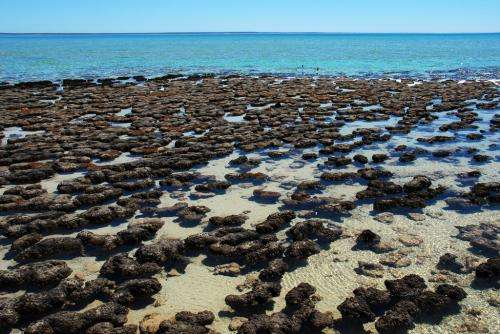Anaerobic microbes surprise scientists by living with oxygen

A study into Shark Bay's microbial mats has detected activity of anaerobic microbes under oxic conditions—highlighting unknown complexities in microbial systems.
The study aimed to provide insight into past environments and to understand how microbial communities contribute to biogeochemical cycles by looking into changes in levels of sulphide, iron and phosphate in salt-water stromatolites over 24 hours.
Lead-author Anais Pages from the WA Organic & Isotope Geochemistry Centre at Curtin University, was surprised with the contradictory results.
"We basically showed that [microbial] communities are a lot more complex then what people previously thought and you do have some obligate anaerobic microbes actually living in contact with oxygen," Dr Pages says.
"Usually the microbial mats are very well organised, so you've got the communities organising themselves depending on the light, oxygen and sulphide gradient."
The microbial mats are determined by vertically changing light regimes and interactions between microbial metabolisms and solutes.
Cyanobacteria grow in the upper portion of the mat, with purple-sulfur bacteria just below and anaerobic green-sulfur bacteria near the bottom.
As a result it is expected that sulphide is present at the bottom of microbial mats while sulphate is apparent at the top.
"You would expect a big difference between day and night because you don't have oxygen being produced at night," Dr Pages says.
"During the day the cyanobacteria will be producing the oxygen through photosynthesis [while] at night there is no light [so] there is no photosynthesis."
The process used colorimetric diffusive equilibration in thin films (DET) and diffusive gradients in thin films (DGT) to measure the co-distributions of sulfide, iron (II) and phosphate.
The techniques unexpectedly showed strong variations in vertical and lateral iron (II) and phosphate distributions, with the changes in phosphate being attributed to daily metabolic changes.
Sulphate (SO42-) labelled silver foils were also used to map the distribution of sulphate-reducing activity.
The foils showed an expected result of high sulphate-reduction activity at the top layers, with low activity in the deeper layers.
The study also involved WA scientists Professor Kliti Grice and Michael Vacher, along with interstate authors Dr David Welsh, Professor Peter Teasdale, Dr William Bennett and Pieter Visscher.
More information: Anais Pages, David T. Welsh, Peter R. Teasdale, Kliti Grice, Michael Vacher, William W. Bennett, Pieter T. Visscher, "Diel fluctuations in solute distributions and biogeochemical cycling in a hypersaline microbial mat from Shark Bay, WA," Marine Chemistry, Available online 11 May 2014, ISSN 0304-4203, dx.doi.org/10.1016/j.marchem.2014.05.003.
Provided by Science Network WA



















